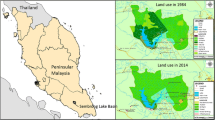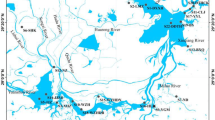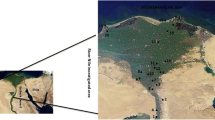Abstract
Organochlorine pesticides (OCPs), including hexachlorocyclohexane and dichlorodiphenyltrichloroethane, were monitored in 37 samples of water collected along the Yangtze River, the third longest river in the world (6,300 km). The total concentration of OCPs (∑OCPs) in the river water ranged from 0.11 to 27.37 ng/L. It was interesting to discover that, except for some sites near industrial cities, levels of OCPs in the water samples were very similar along the whole river. Significantly, OCPs were detected in Tuotuo River (the origin of Yangtze River) even though OCPs have never been used in this area because of its 4,540 m height above sea level. Furthermore, it was found that ∑OCPs was related to temperature and altitude along the river. We assume OCPs are transported along the Yangtze River, and the factors affecting this process are discussed.









Similar content being viewed by others
References
Bailey R, Barrie LA, Halsall CJ, Fellin P, Muir DCG (2000) Atmospheric organochlorine pesticides in the western Canadian Arctic: evidence of trans-pacific transport. J Geophys Res 105:11805–11811
Blais JM, Schindler DW, Muir DCG, Kimpe LE, Donald DB, Rosenberg B (1998) Accumulation of persistent organochlorine compounds in mountains of western Canada. Nature 395:585–588
Chen DZ, Liu WJ, Liu XD, Westgate JN, Wania F (2008) Cold-Trapping of Persistent Organic Pollutants in the Mountain Soils of Western Sichuan, China. Environ Sci Technol 42:9086–9091
Daly GL, Wania F (2005) Organic contaminants in mountains. Environ Sci Technol 39:385–398
Davidson DA, Wilkinson AC, Blais JM, Kimpe LE, McDonald KM, Schindler DW (2003) Orographic cold-trapping of persistent organic pollutants by vegetation in mountains of Western Canada. Environ Sci Technol 37:209–215
Doong RA, Lee SH, Lee kCC, Sun YC, Wu SC (2008) Characterization and composition of heavy metals and persistent organic pollutants in water and estuarine sediments from Gao-ping River, Taiwan. Mar Pollut Bull 57:846–857
Gao F, Jia JY, Wang H, Yang ZF (2006) Characteristics of HCH residue in agricultural soil of Guangzhou. Environ Sci Technol 29:10–14
Gouin T, Mackay D, Jones KC, Harner T, Meijer SN (2004) Evidence for the ‘grasshopper’ effect and fractionation during long-range atmospheric transport of organic contaminants. Environ Pollut 128:139–148
Gregor DJ, Gummer WD (1989) Evidence of atmospheric transport and deposition of organochlorine pesticides and polychlorinated biphenyls in Arctic snow. Environ Sci Technol 23:1528–1531
Grimalt JO, Fernandez P, Berdie L, Vilanova RM, Catalan J, Psenner R, Hofer R, Appleby PG, Rosseland BO, Lien L, Massabuau JC, Battarbee RW (2001) Selective trapping of organochlorine compounds in mountain lakes of temperate areas. Environ Sci Technol 35:2690–2697
Harner T, Wideman JL, Jantunen LMM, Bidleman TF, Parkhurst WJ (1999) Residues of organochlorine pesticides in Alabama soils. Chemosphere 106:323–332
Li YF, Cai DJ, Singh A (1998) Hexachlorocyclohexane use trends in China and their impact on the environment. Arch Environ Contam Toxicol 35:688–697
Middeldorp PJM, Jaspers M, Zehnder AJB, Schraa G (1996) Biotransformation of α-, β-, γ-, and δ-hexachlorocyclohexane under methanogenic conditions. Environ Sci Technol 30:2345–2349
Munn MD, Gruber SJ (1997) The relationship between land use and organochlorine compounds in streambed sediment and fish in the central Columbia plateau, Washington and Idaho, USA. Environ Toxicol Chem 16:1877–1887
Pacyna JM, Oehme M (1988) Long-range transport of some organic compounds to the Norwegian Arctic. Atmos Environ 22:243–257
Pham T, Lum K, Lemieux C (1996) Seasonal variation of DDT and its metabolites in the St. Lawrence River (Canada) and four of its tributaries. Sci Total Environ 179:17–26
Qiu LM, Zhang JY, Luo YM (2005) Residues of HCH and DDT in agricultural soils of north of Zhejiang and its risk evaluation. J Agro-Environ Sci 24:1161–1165
Ribes A, Grimalt JO, Garcia CJT, Cuevas E (2002) Temperature and organic matter dependence of the distribution of organochlorine compounds in mountain soils from the subtropical Atlantic (Teide, Tenerife Island). Environ Sci Technol 36:1879–1895
Shen HQ, Henkelmann B, Levy W, Zsolnay A (2009) Altitudinal and chiral signature of persistent organochlorine pesticides in air, soil, and spruce needles (Picea abies) of the Alps. Environ Sci Technol 43:2450–2455
Simonich SL, Hites RA (1995) Global distribution of persistent organochlorine compounds. Science 269:1851–1854
Walker K, Vallero DA, Lewis RG (1999) Factors influencing the distribution of Lindane and other hexachlorocyclohexanes in the environment. Environ Sci Technol 33:4373–4378
Wania F, Mackay D (1993) Global fractionation and cold condensation of low volatility organochlorine compounds in polar regions. Ambio 22:10–18
Wania F, Mackay D (1995) A global distribution model for persistent organic chemicals. Sci Total Environ 161:211–232
Wania F, Westgate JN (2008) On the mechanism of mountain coldtrapping of organic chemicals. Environ Sci Technol 42:9092–9098
Welch HE, Muir DCG, Billeck BN, Lockhart WL, Brunskill GJ, Kling HJ, Olson MP, Lemoine RM (1991) Brown snow: a long-range transport event in the Canadian Arctic. Environ Sci Technol 25:280–286
Willet KL, Ulrich EM, Hites RA (1998) Differential toxicity and environmental fates of hexachlorocyclohexane isomers. Environ Sci Technol 32:2197–2207
Yang JM, Wang Y, Su QQ (2004) Investigation of organochlorine pesticides residue in the suspended solid of Wuhan section of the Yangtze River. Res Environ Sci 17:27–38
Zhang YY, Feng LL, Zheng T (2007) Health risk assessment on semivolatile organic compounds in Water of Yangtze Estuary Area. Res Environ Sci 20:18–23
Zhi X, Niu JF, Tang ZW, Yang ZF (2008) Ecological risk assessment of typical organochlorine pesticides in water from the Wuhan reaches of the Yangtze River. Acta Sci Circum 28:168–173
Zhu YF, Liu H, Xia ZQ, Cheng HX, Xu XB (2005) Organochlorine pesticides (DDTs and HCHs) in soils from the outskirts of Beijing, China. Chemosphere 60:770–778
Acknowledgments
This research was financially supported by the Specialized Research Fund for the Doctoral Program of Higher Education in China (20090022120001) and China Geological Survey (GZTR02-01, 2008).
Author information
Authors and Affiliations
Corresponding author
Rights and permissions
About this article
Cite this article
Liu, C., Yuan, GL., Yang, ZF. et al. Levels of organochlorine pesticides in natural water along the Yangtze River, from headstream to estuary, and factors determining these levels. Environ Earth Sci 62, 953–960 (2011). https://doi.org/10.1007/s12665-010-0580-9
Received:
Accepted:
Published:
Issue Date:
DOI: https://doi.org/10.1007/s12665-010-0580-9




